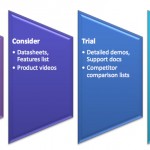Traffic
Traffic is the first T in Testing. According to statistics, your campaigns must be seen by hundreds or even thousands of customers to accurate detect which message is winning. This is called statistical significance. It’s the likelihood that you would have the same results 95% of the time if you repeat the test.
Not having enough traffic is the most common barrier to testing. Anyone can test, but if it takes several months to achieve statistical significance, then it may not be worth your time or investment.
Technology
There are several testing platforms including Google Website Optimizer, SiteSpect. They are powerful technologies, but should be incorporated once you’ve mastered the basics. These technology capabilities are minimum:
- You need to be able to split your traffic into each of your test groups. This means randomly exposing each customer to a test experience.
- You need to be able to track the behavior of your customers in each test separately using your web analytics tags.
Time
Giving your testing program enough time is crucial. Testing takes at least twice as long as a standard campaign. There is more creative development, more planning and more analysis. Testing should not be treated like a single campaign or individual project. It’s actually a broader shift in thinking about marketing. In fact, the key drivers in your marketing results, such as your offer emails, subject lines, newsletters should all be tested constantly and even indefinitely.
Trust
When it comes to testing, you need to trust your data. This means that you need to have strong web analytics. It has to be so trustworthy that you are willing to take action based on the results, even if it goes against your intuition.
Team
Lastly, testing requires the cross-functional skills of a team. First, a marketing strategist needs to decide what to test. Then, a designer and a copywriter need to create the campaign itself. Then, a web developer needs to build the page, tag it, and launch it. You’ll need the support of IT to split traffic to each of the test cells, and QA everything to make sure it doesn’t break anything else on the site. Lastly, you’ll need some help from a web analyst to pull reports and interpret the results. It can be a big effort, but it’s worth it!
Testing is a proven strategy that is still an untapped way to make marketing more measurable, accountable and effective. With lots of time, traffic, a strong team, trustworthy data, and good technology; you’ll have the right recipe for a winning testing formula.








What a great resource. So many nuances to improve the overall user experience AND improve the bottom line. Split testing is completely under-utilized. Why guess when you can actually KNOW what works. Thanks for the help, keep the great advice and resources coming!
When Beth said she could help me understand my analytics on my website, I was in dire need of help. I was getting a lot of traffic but the direction of the traffic, what it all meant in terms of conversations, and my overall knowledge of Google Analytics was severely lacking. Beth Bijou came in and took a look under my website’s hood by accessing my Google Analytics. She reviewed the information and provided me with a beautiful presentation that explained what everything meant in a manner that anyone could understand, especially a guy like myself who is new to the technology industry.
I was very satisfied with her professionalism, the timeliness and quality of the deliverable, and for her patience in educating me about what everything meant for my website. She provided recommendations on how best I could optimize the opportunity to convert my web traffic into tangible results, and I highly recommend Beth to anyone looking for a deep analysis of analytic with measurable results and deliverables.
We’ve tapped BijouMind Interactive for our social networking projects several times in the past few years, and they have delivered their objectives with flying colors every time. We are very confident that the team behind Beth Bijou is dedicated to good service and the success of any project they are tasked to do. I would highly recommend them for social campaigns any day.